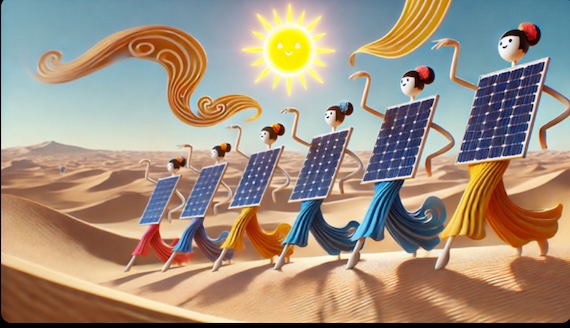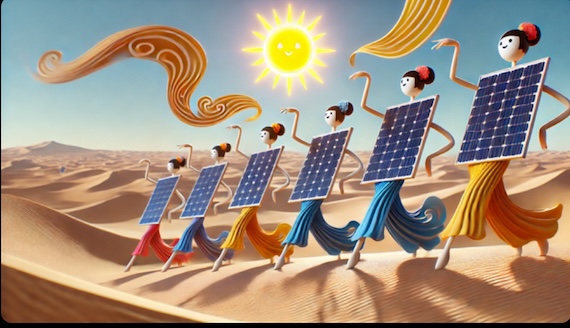Ann Arbor (Informed Comment) – Chinese firms dominate the manufacture of photovoltaic solar panels, accounting for 80% of the global market (along with most elements of the supply chain). Volumes in China’s solar sector, including panels, batteries and EVs, expanded by a third in 2024, even though panel prices had plummeted.
The Chinese will, however, run into headwinds with the Trump administration, which is not only imposing a 10% tariff on Chinese imports in general but hitting solar panels with 60% duties.
Eva Lavesque at Arabian Gulf Business Insight reports that Chinese solar firms are eyeing the Middle East market to offset declining US margins. The solar giant Trinasolar shipped 240 gigawatts of solar modules worldwide in the first three quarters of 2024.
The US only produced 4 gigawatts of solar panel PV modules in the first two quarters of 2024. That is, we are not even in the same league as China. We’re a podunk farm team for solar panel manufacturing and China is the winner of the world series. Although the US under the Biden administration ramped up its solar panel manufacturing capacity to 50 gigawatts, given Trump’s punitive policies toward green energy a lot of that capacity could remain unfulfilled.
Lavesque says Trinasolar did relatively minor business in the Middle East in 2024, exporting 3 gigawatts of solar panels there, but it plans to double that to 6 gigawatts in the coming year.
I wrote elsewhere about how the inexpensive price of Chinese solar panels this year allowed Pakistani peasants to install 17 gigawatts of solar capacity in their villages, without any government help at all, which catapulted Pakistan into being the sixth largest global market for solar. In one year. Done by the people. In the Middle East, which doesn’t have regular elections or stable political parties and so is more centralized than South Asia, it is likely that the governments will have to be more involved.
The Chinese company JA Solar Technology Co Ltd will supply both the panels and a mega-battery for the 500-megawatt Abydos II solar farm in Aswan governorate, to which will be attached 600 megawatt hours of batteries. The batteries will store energy generated by the sun in daylight for use at night. The actual construction of the solar farm will be carried out by the China Energy Engineering Corporation. Dubai’s AMEA Power brokered the deal. Covering nearly 8 square miles, the solar installation will be Africa’s largest when it is completed. It will power some 300,000 households out of Egypt’s 22 million households.
China is also turning to co-manufacturing panels in Egypt. Xinhua reports that Ms. Ghada al-Gendy, the head of Egypt’s Arab Company for Renewable Energy, said in an interview, “We recently acquired a new production line from China, a state-of-the-art system that will boost our production capacity significantly. Our existing Italian line produces 52 megawatts annually, but this new Chinese line will produce a remarkable 1 gigawatt. That’s a game-changer for us, and it positions us to play a much larger role in Egypt’s renewable energy future.”
That is, Chinese firms are siting panel production in places like Egypt, in collaboration with local Egyptian firms. Trinasolar believes that such Sino-Egyptian solar products will be easy to export around the world, since they will be seen as “made in Egypt” and won’t suffer the penalties placed on Chinese exports by Europe and the US.

“Solar,” Digital, ChatGPT, 2025
Egypt has the goal of generating 40 gigawatts of electricity with renewables over the next few years. It is currently heavily dependent on fossil gas, some of which it produces and the rest of which it imports at high prices. Egypt’s domestic fossil gas production was down last year, the price of imported gas soared, and consumer demand increased substantially, producing electricity blackouts and brownouts. The electricity shortages, which hit consumers hard in Egypt’s torrid summers and hurt small factories, are a powerful impetus to turn to solar. Egypt has plentiful sunshine and lots of desert where panels can be installed.
Chinese solar is increasingly being seen as a solution to this problem.
In the 1950s, the equivalent of Abydos II was the Aswan Dam, which helped supply Egypt with the electricity to industrialize. That massive project was initiated by the United States. But the Republicans in the Eisenhower era hated Egypt because it nationalized the Suez Canal and took an anti-imperialist stand. It helped found the non-aligned movement with India and Indonesia and recognized China.
So in 1956 the Eisenhower administration cut Egypt off. If this move was intended to make Egypt’s Gamal Abdel Nasser bend the knee, it failed miserably. It pushed him into the arms of the Soviet Union. It was the Soviets who built the Aswan Dam. Premier Nikita Khrushchev received a warm welcome in Cairo in 1964.
Today, the Republicans are punishing America’s solar and wind industries, giving China the opening to become the major player in the Middle East’s growing clean energy infrastructure, with the United Arab Emirates as a key broker. This time we could lose not just Egypt but the whole region, if it becomes dependent on Chinese technology. Once you adopt a technological system that all works together, it is hard to dump it in favor of another one.
Once the world’s most advanced technological society, America under Trump is sinking into backwardness, as lean, hungry competitors make the breakthroughs and leave us in the dust.



 © 2025 All Rights Reserved
© 2025 All Rights Reserved